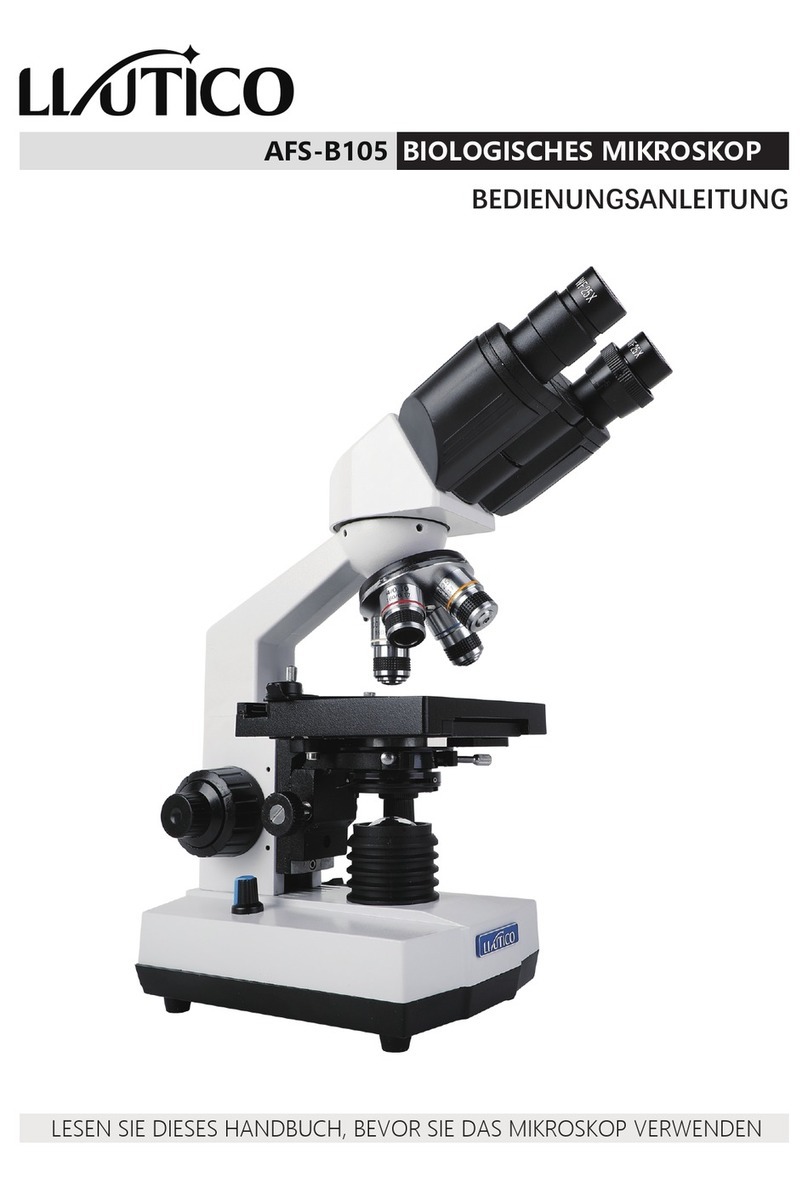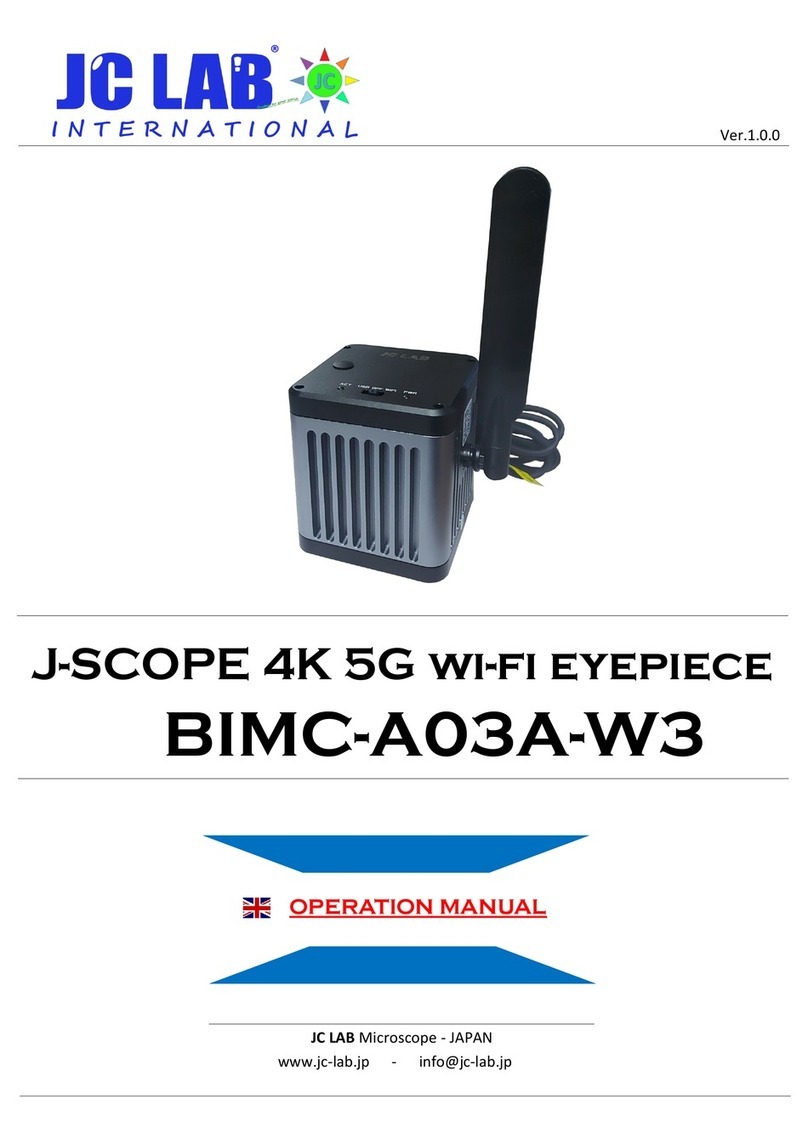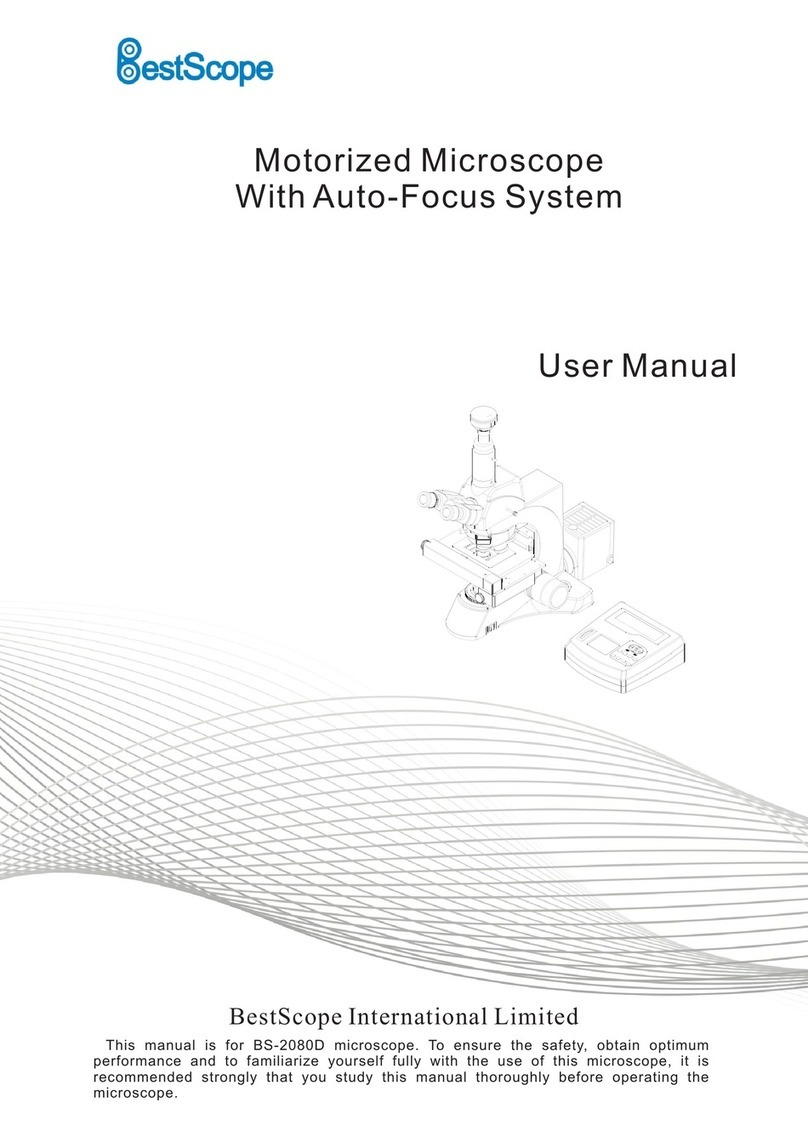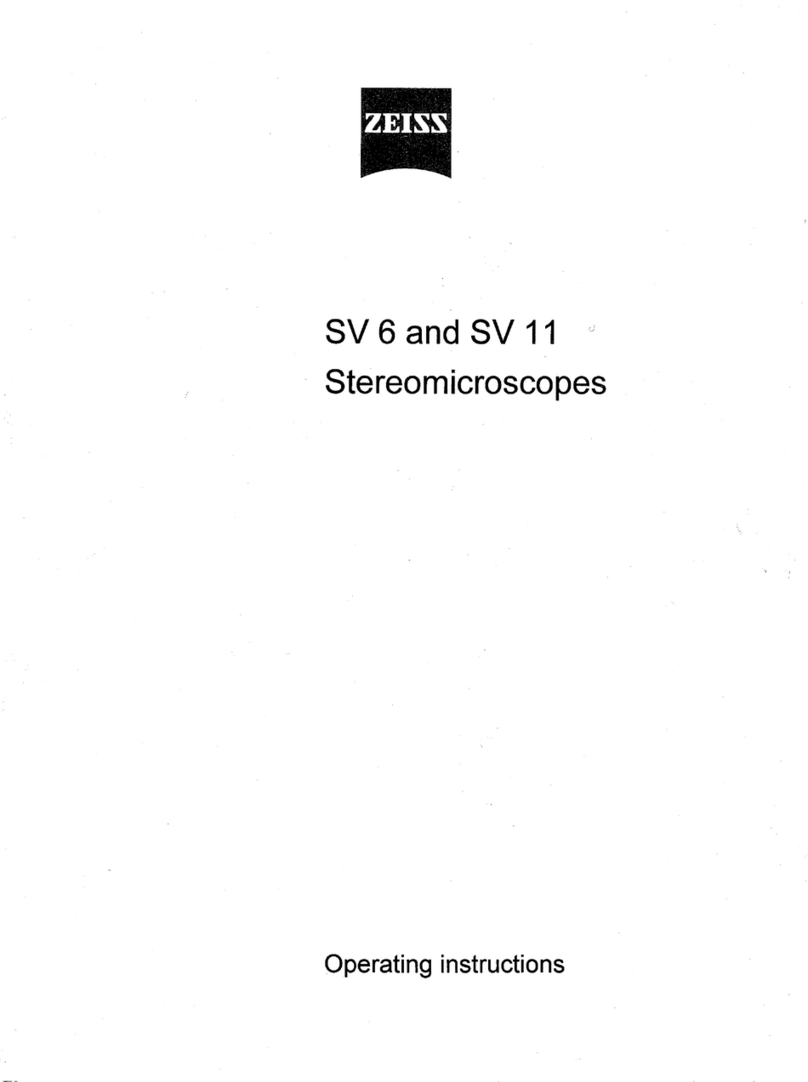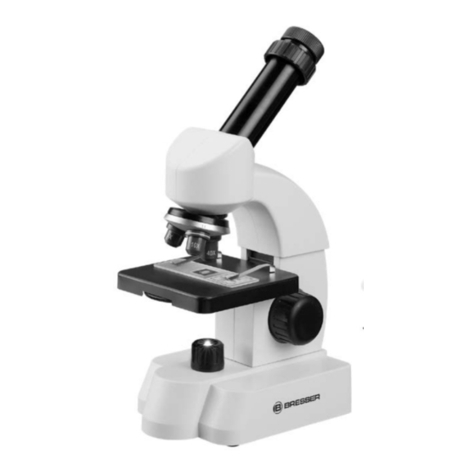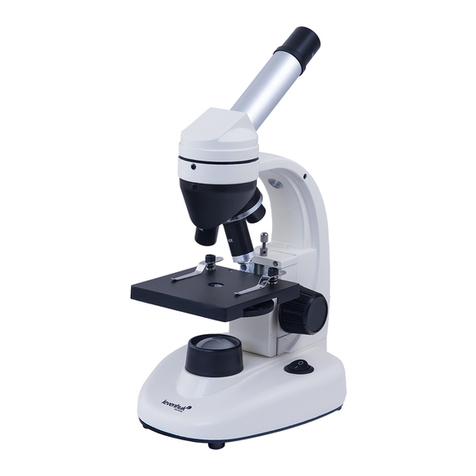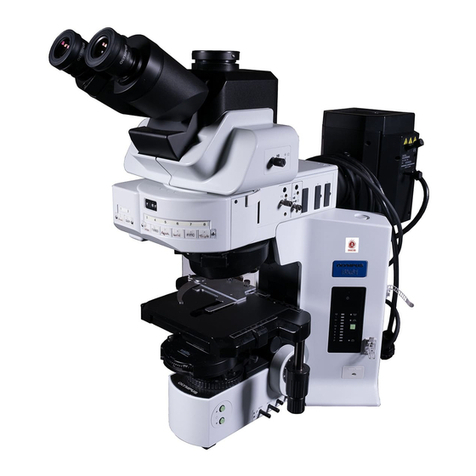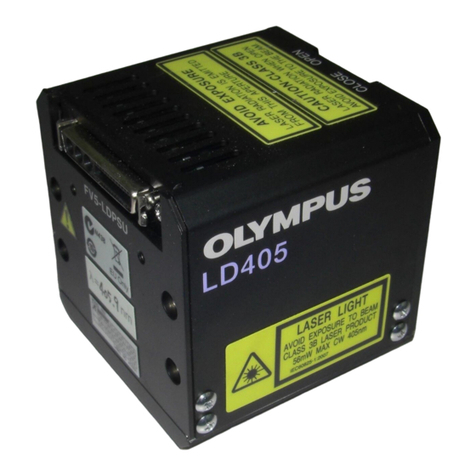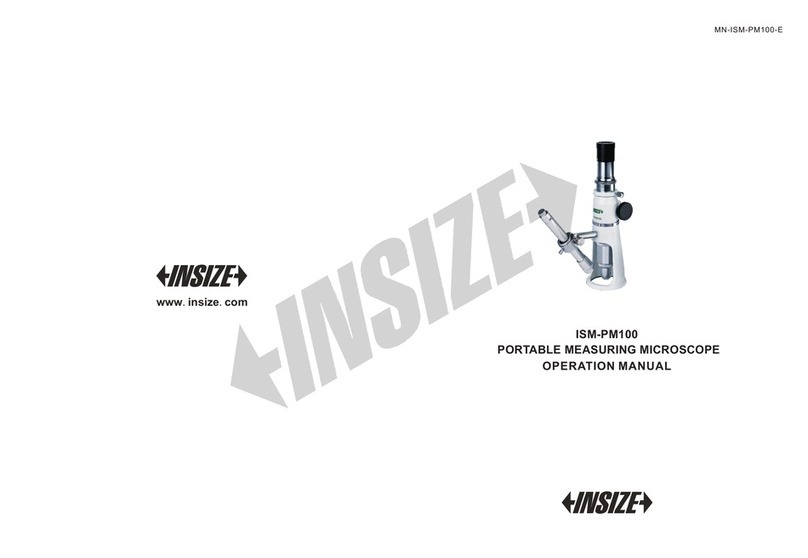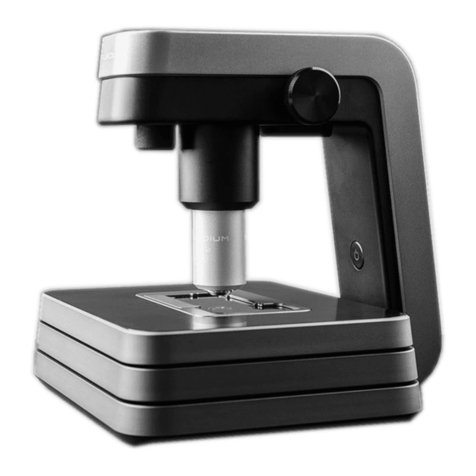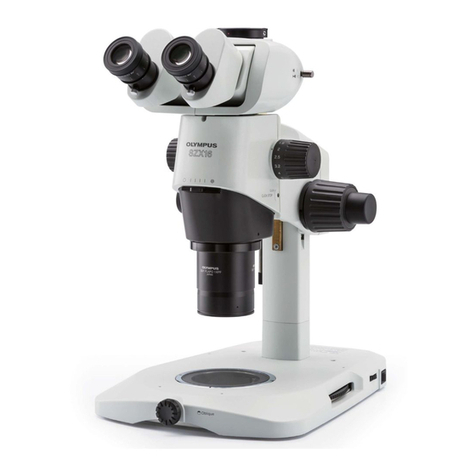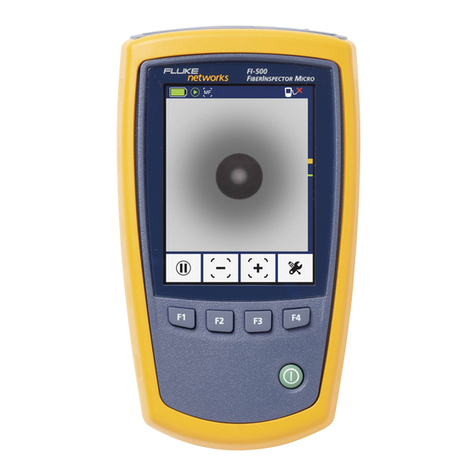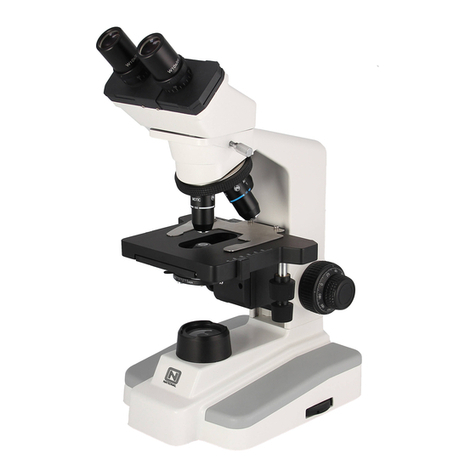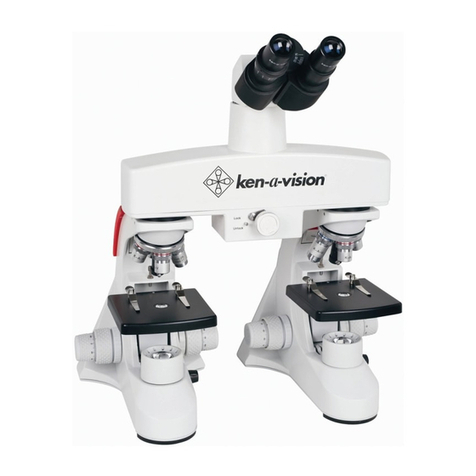Explore One 900x User manual

How Do I Use My Microscope
Before you use your microscope, make sure that the table, desk or surface
that you place it on is stable and is not subject to vibration. If the microscope
needs to be moved, hold it by the arm and base while carefully transferring
it. Once the microscope is in a suitable location and the batteries are
installed, check the light source to make sure that it illuminates. Use a
microfiber cleaning cloth to gently wipe the lenses off. If the stage is dirty
with dust or oil, carefully clean it off. Make sure that you only raise and lower
the stage using the focus adjustment knob.
Install Batteries
1. Remove button screws
and cover.
2. Install batteries with the
positive (+) and negative
(-) in the correct direction
indicated by the battery
compartment label.
3. Replace the cover and
screws.
How Do I Operate The Illumination?
Locate the mirror/light on the base of the microscope. Flip the mirror/light
to the “on” position (with the light facing up) and the light will illuminate.
This microscope is equipped with an incandescent light that illuminates the
specimen from below.
How Do I Adjust My Microscope Correctly?
Place the microscope in a suitable location as described above, and sit
in a comfortable viewing position. Always start each observation with the
lowest magnification. Adjust the distance of the microscope stage so that
the stage is in the lowest position — farthest away from the turret head.
Turn the objective turret until it clicks into place at the lowest magnification
(Objective: 5x/Magnification: 100x). Note: Before you change the objective
setting, always make sure the microscope stage is farthest away from
the turret by rotating the focus knob. Separating the stage and turret by
rotating the focus knob will avoid causing damage to the specimen slide or
microscope. When starting an observation, always start with the 5x objective
in the rotating head.
How Do I Observe The Specimen?
Sitting in your location with adequate illumination chosen from the color
filter wheel, the following basic rules should be observed. Start with a simple
observation at the lowest magnification. Position the object or specimen in the
middle of the stage under the stage clips, centered over the lower light. Focus
the image by rotating the focus knob until a clear image appears in the eyepiece.
Place the prepared slide directly under the objective on the microscope stage
and secure it with the stage clips. The prepared slide should be located directly
over the lower illumination. Look through the eyepiece and carefully turn the
focus knob until the image appears clear and sharp. Now you can select a
higher magnification by rotating to the 15x/300x objective turret. Higher levels
of magnification can be achieved by turning the objective turret to a higher
setting (300x or 900x). Following this procedure creates a steady increase
of magnification without overpowering the view of the object. The following
magnification order should be used: 100x, 300x then 900x. Each time the
magnification changes (due to the objective change), the image sharpness must
be readjusted with the focus knob. When doing this, be careful because if you
move the microscope stage too quickly, the objective and the slide could come
into contact and cause damage to the slide or microscope.
For transparent objects (e.g. sea salt), light is projected by the lower light
traveling from below the stage, through the objective and eyepiece, and finally
into your eye. This process of light transmission is known as microscopy. Many
micro-organisms found in water, plant components and the smallest animal
parts are transparent in nature. Opaque specimens, on the other hand, will
need to be prepared for viewing. Opaque specimens can be made transparent
by a process of treatment and penetration with the correct materials (media),
or by slicing. You can read more about creating specimens in the enclosed
microscope experiments booklet.
Did You Know?
The highest magnification is not always the best for every specimen!
Troubleshooting Guide:
Problem Solution
No recognizable image Turn on light, Readjust focus,
Start with the lowest power objective (5x)
No image Centre object on slide under
lowest power objective
No light Replace batteries, Check on/off position
Magnification Guide:
Eyepiece Objective Power
20x 5x 100x
20x 20x 400x
20x 45x 900x
SAFETY WARNINGS
• THIS MICROSCOPE SET IS
INTENDED FOR CHILDREN
OLDER THAN AGE
8
.
CHILDREN SHOULD ONLY
USE THIS DEVICE UNDER
ADULT SUPERVISION.
NEVER LEAVE A CHILD
UNSUPERVISED WITH THIS
DEVICE. ACCESSORIES IN
THE EXPERIMENT KIT MAY
HAVE SHARP EDGES AND
TIPS. PLEASE STORE THE
DEVICE AND ALL OF ITS
ACCESSORIES AND AIDS
OUT OF THE REACH OF
YOUNG CHILDREN WHEN
NOT BEING USED DUE
TO A RISK OF INJURY.
• CHEMICALS: ANY
CHEMICALS AND LIQUIDS
USED IN CONJUNCTION
WITH THE DEVICE SHOULD
BE KEPT OUT OF REACH OF
CHILDREN. DO NOT DRINK
ANY OF THE CHEMICALS
CONTAINED IN THIS SET.
HANDS SHOULD BE WASHED
THOROUGHLY UNDER
RUNNING WATER AFTER
WORKING WITH THESE
CHEMICALS. IN CASE OF
ACCIDENTAL CONTACT
WITH EYES OR MOUTH,
RINSE THE AFFECTED
AREA WITH WATER. SEEK
MEDICAL TREATMENT
FOR AILMENTS ARISING
FROM CONTACT WITH THE
CHEMICAL SUBSTANCE,
AND TAKE THE CHEMICALS
WITH YOU TO THE DOCTOR.
• CHOKING HAZARD:
CHILDREN SHOULD ONLY
USE DEVICE UNDER ADULT
SUPERVISION. KEEP
PACKAGING MATERIALS
LIKE PLASTIC BAGS AND
RUBBER BANDS OUT OF
THE REACH OF CHILDREN
AS THESE MATERIALS POSE
A CHOKING HAZARD.
• BATTERY GUIDELINES:
THIS DEVICE CONTAINS
ELECTRONIC COMPONENTS
THAT ARE POWERED BY
BATTERIES. BATTERIES
SHOULD BE KEPT OUT OF
CHILDREN’S REACH. WHEN
INSERTING BATTERIES,
PLEASE ENSURE THE
POLARITY IS CORRECT.
INSERT THE BATTERIES
ACCORDING TO THE
DISPLAYED +/- INFORMATION.
NEVER MIX OLD AND NEW
BATTERIES. REPLACE ALL
BATTERIES AT THE SAME
TIME. NEVER MIX ALKALINE,
STANDARD CARBON-ZINC
AND RECHARGEABLE
NICKEL-CADMIUM
BATTERIES. NEVER SHORT
CIRCUIT THE DEVICE OR
BATTERIES OR THROW
EITHER INTO A FIRE. LEAKING
OR DAMAGED BATTERIES
CAN CAUSE INJURY IF
THEY COME INTO CONTACT
WITH THE SKIN. IF YOU
NEED TO HANDLE SUCH
BATTERIES, PLEASE WEAR
SUITABLE SAFETY GLOVES.
REMOVE BATTERIES FROM
THE PRODUCT BEFORE
EXTENDED STORAGE TO
PREVENT LEAKING. DO NOT
IMMERSE THE BATTERY
COMPARTMENT IN WATER.
• RISK OF FIRE: DO
NOT PLACE DEVICE,
PARTICULARLY THE LENSES,
IN DIRECT SUNLIGHT. THE
CONCENTRATION OF LIGHT
RAYS COULD CAUSE A FIRE.
• DO NOT DISASSEMBLE
THIS DEVICE. IN THE EVENT
OF A DEFECT, PLEASE
CONTACT YOUR DEALER.
THE DEALER WILL CONTACT
THE CUSTOMER SERVICE
DEPARTMENT AND CAN
SEND THE DEVICE IN TO BE
REPAIRED IF NECESSARY.
• DO NOT SUBJECT THE
DEVICE TO TEMPERATURES
EXCEEDING 60 °C (140 °F).
• DISPOSAL: KEEP
PACKAGING MATERIALS,
LIKE PLASTIC BAGS AND
RUBBER BANDS, AWAY
FROM CHILDREN AS
THEY A POSE A RISK OF
SUFFOCATION. DISPOSE
OF PACKAGING MATERIALS
AS LEGALLY REQUIRED.
CONSULT THE LOCAL
AUTHORITY ON THE
MATTER IF NECESSARY
AND RECYCLE MATERIALS
WHEN POSSIBLE.
READ AND FOLLOW THE INSTRUCTIONS, SAFETY RULES, AND FIRST AID INFORMATION.

*Not suitable for children under 8 years of age. Contains functional sharp points.
Microscope Parts:
01. Eyepiece
02. Focus Knob
03. Stage
04. Stage Clips
05. Objective
06. Objective Turret (5x, 20x, 45x)
07. Illumination On/Off Switch and Mirror
08. Rubber Base and Battery Case
09. Microscope Arm
10. (5) Prepared Slides and (7) Blank Slides with Slide Case
11. (8) Slide Covers/Labels
12. (2) Collection Vials
13. Test Tube
14. Petri Dish
15. Scalpel / Needle* / Tweezers / Stirring Rod
16. Slicer
17. Blue Dye / Red Dye / Sea Salt / Brine Shrimp Eggs
18. Hatchery
88-50101
© 2018 EXPLORE ONE
1010 S 48th Street, Springdale, AR 72762
exploreone.com | 866.252.3811
All rights reserved. Made in China.
CONFORMS TO THE SAFETY
REQUIREMENTS OF ASTM F963
CHOKING HAZARD
— Small parts.
Not for children under 8 years.
WARNING:
FUNCTIONAL SHARP POINT
— Not for
children under 8 years.
WARNING:
900x MICROSCOPE SET
INSTRUCTION MANUAL
Ages
8+
NOT INCLUDED
X2
Do not mix old and new batteries. Do not mix alkaline,
standard (carbon-zinc), or rechargeable (ni-cad, ni-mh, etc.) batteries.
Non-rechargeable batteries are not to be recharged.
01
02
03
05
06
07
08
09
10
10
11
12
18
13
14
15
16
17
04
Other Explore One Microscope manuals

